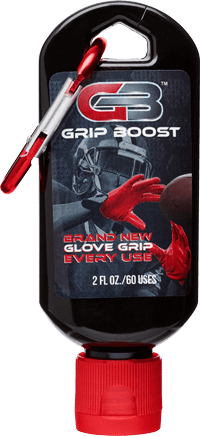- October 21, 2016
- By Chris Carroll
As a high school football player, Matt Furstenburg ’12 hoarded precious pairs of receiving gloves that hadn’t lost their tackiness—helpful for hauling in fingertip touchdown catches.
“I didn’t want to wear out my game gloves during practice, so I didn’t wear them,” he says.
It was far less of a problem after he became a tight end for the Terps football team, which budgets thousands of dollars a year just for gloves. But Furstenburg thought back to his earlier plight, wondering how to revive gloves that had stopped sticking but otherwise were in good shape—potentially saving young players the $25 or more that new gloves cost.
 He took his idea to the Dingman Center for Entrepreneurship and hashed it out with Harry Geller, a local businessman with a knack for starting successful companies and one of the center’s entrepreneurs in residence. Geller liked the concept so much that he agreed to co-found Grip Boost LLC with Furstenburg.
He took his idea to the Dingman Center for Entrepreneurship and hashed it out with Harry Geller, a local businessman with a knack for starting successful companies and one of the center’s entrepreneurs in residence. Geller liked the concept so much that he agreed to co-found Grip Boost LLC with Furstenburg.
“We toyed around with how to solve it—a spray or a gel recoating—but neither of us are chemical engineers,” says Geller, “so we connected with Srinivasa Raghavan,” a professor of chemical and bioengineering and head of the Complex Fluids and Nanomaterials group. Two of Raghavan’s former students—Chanda Arya Ph.D. ’14 and Kevin Diehn M.S. ’14—became the scientific end of Grip Boost.
They needed to develop a product tacky enough to help receivers snag balls, but not so sticky it violates football rules. And it had to dry almost instantly so players could get back into the game. After formulating scores of rub-on gels using strategically modified chitosan—a material derived from the shells of crab and other shellfish—they finally settled on one that Furstenburg knew would meet the needs of football receivers.
Available online and increasingly in sporting goods stores, Grip Boost is gaining traction with young players and their coaches, Diehn says.
“We went from selling 300 bottles in 2014 to selling 10,000 bottles in 2015,” with sales on track to exceed 30,000 in 2016, he says.
The company recently introduced a version formulated especially to replace messy pine tar in baseball, and is considering versions for golf and other sports as well. Grip Boost is also looking at industrial uses for its technology, Geller says.
“Sport was a natural place to start,” he says. “But our mission really is to be all things grip.”
Tags
Research